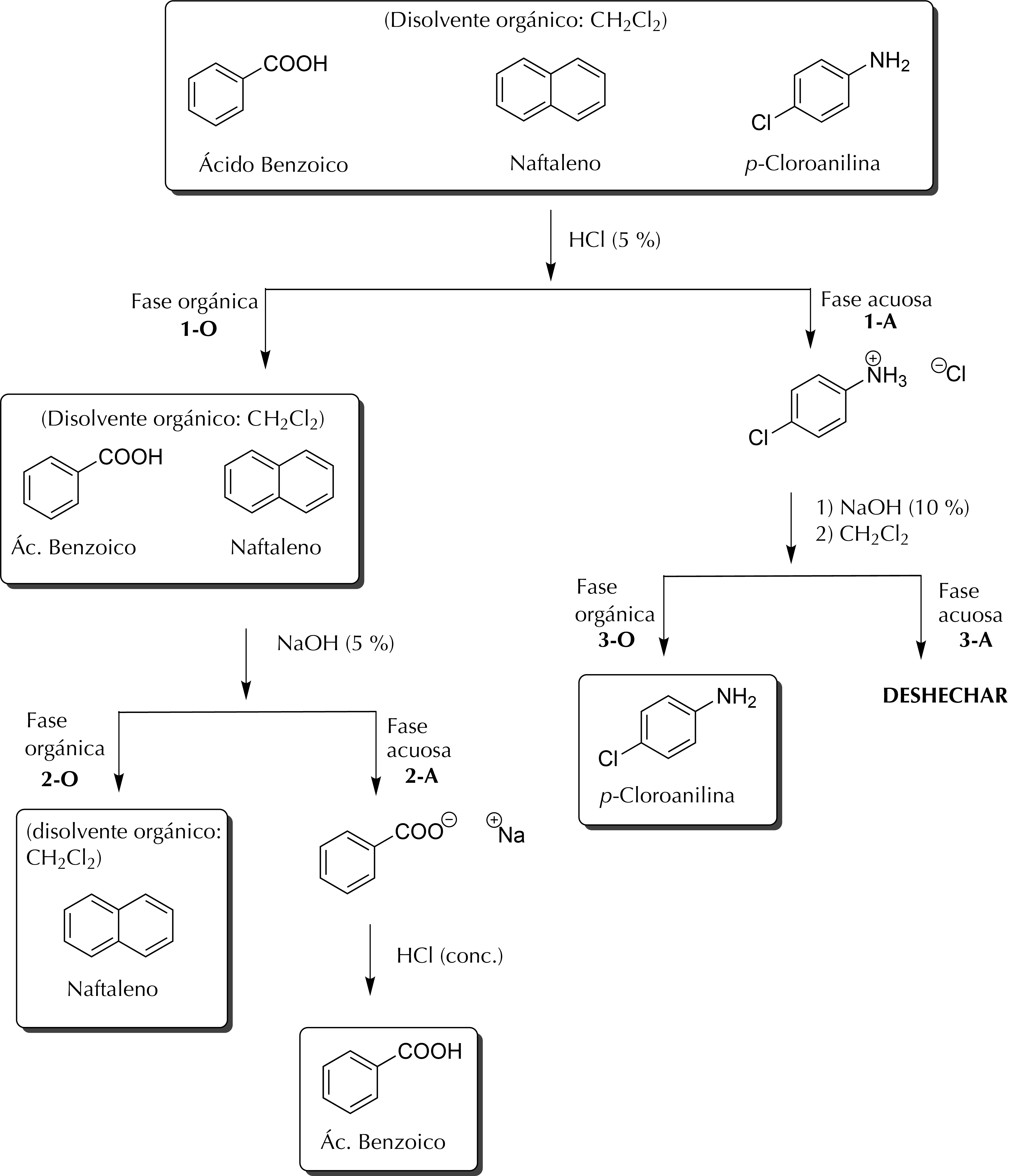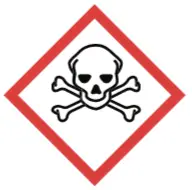Written by J.A Dobado | Last Updated on April 22, 2024
Objective
Learn how different organic compounds can be isolated according to their acid-base properties, which change their solubility in organic and aqueous solvents, by liquid-liquid extraction.
 |  |  |
 |  |  |
Background
The liquid-liquid extraction is one of the most common basic operations in the organic chemistry laboratory, as many reactions involve the use of this technique for product isolation. Carboxylic acids can react with bases such as sodium hydroxide, producing a proton and forming the corresponding water-soluble anions (carboxylates). On the other hand, amines in acidic media produce water-soluble ions generated by protonation, such as ammonium salts. This experiment involves the separation of the components of a mixture consisting of naphthalene, p-chloroaniline, and benzoic acid, which will be dissolved in an organic solvent such as CH2Cl2, depending on the acid or basic character of these compounds.
Procedure
Three-component separation (mixture of an acidic, basic and neutral compound): Take 30 ml of a test solution containing an organic solvent (CH2Cl2) and three different dissolved compounds with neutral, basic and acidic character, such as: naphthalene, p-chloroaniline and benzoic acid, respectively. Place the 30 ml of the problem solution in a 250 ml separatory funnel. Add 40 ml of a 5% hydrochloric acid HCl solution and shake vigorously. Allow to stand and then separate the two layers (the aqueous layer is the upper layer and the organic layer, CH2Cl2, the lower one).
The organic layer 1-O, is re-treated in an extraction funnel with 40 ml of a 5% NaOH solution, separating the two layers. The organic 2-O (lower) layer is dried with anhydrous Na2SO4 for a few minutes. Remove the desiccant by gravity filtration. Transfer the filtrate to a dry round bottom flask, and evaporate the solvent to dryness at rotavapor. The neutral component of the mixture is obtained as a solid of characteristic odor, naphthalene. The aqueous layer 2-A, is made acidic (use indicator paper) by adding small portions of HCl (conc.). Cool the mixture and vacuum filter (Kitasato and Büchner), the crystalline product obtained is the acid component of the problem mixture, benzoic acid.
The aqueous layer 1-A, is treated by adding small portions of NaOH (10%) and cooling the mixture to room temperature if necessary (an oily substance will appear), until it becomes basic (use indicator paper). Extract (in a separating funnel) this basic solution with CH2Cl2 (20 ml); After collecting the organic layer 3-O (bottom) in a 100 ml Erlenmeyer flask, dry with anhydrous Na2SO4 for a few minutes. Then gravity filter (funnel and pleated filter) and the filtrate is collected in a dry 100 ml round bottom flask, which is taken to rotavapor to remove the solvent, CH2Cl2, leaving a white solid which is the basic component of the problem mixture: p-chloro-aniline. The aqueous 3-A (upper)layer 3-A (upper) is broken up.
General scheme of separation

Physico-chemical properties
This table collects data for the molecular weight (Mw), melting point (M.p.) boiling point (B.p.) and density of the reactives and compounds used in this laboratory experiment.
| Name | Mw (g/mol) | M.p. (ºC) | B.p. (ºC) | Density (g/ml) |
| Benzoic acid | 122.12 | 125 | 249 | 1.08 |
| Naphthalene | 128.17 | 79.5-81.0 | 218 | - |
| p-Chloroaniline | 127.57 | 72.5 | 232 | 1.140 |
| CH2Cl2 | 84.93 | -97 | 40.0 | 1.33 |
| NaOH | 40.00 | 318 | 1,390 | 2.130 |
| HCl | 36.46 | -30 | >100 | 1.200 |
| Na2SO4 | 142.04 | 884 | - | 2.630 |
GHS pictograms
Hazard pictograms form part of the international Globally Harmonized System of Classification and Labelling of Chemicals (GHS) and are collected in the followinf Table for the chemical compounds used in this experiment.
| Name | GHS |
| Benzoic acid |   |
| Naphthalene |    |
| p-Chloroaniline |    |
| CH2Cl2 |  |
| NaOH |  |
| HCl |   |
| Na2SO4 | Non-hazardous |
International Chemical Identifier
The IUPAC InChI key identifiers for the main compounds used in this experiment are provided to facilitate the nomenclature and formulation of chemical compounds and the search for information on the Internet for these compounds.
| Benzoic acid | WPYMKLBDIGXBTP-UHFFFAOYSA-N |
| Naphthalene | UFWIBTONFRDIAS-UHFFFAOYSA-N |
| p-Chloroaniline | QSNSCYSYFYORTR-UHFFFAOYSA-N |
| CH2Cl2 | YMWUJEATGCHHMB-UHFFFAOYSA-N |
| NaOH | HEMHJVSKTPXQMS-UHFFFAOYSA-M |
| HCl | VEXZGXHMUGYJMC-UHFFFAOYSA-N |
| Na2SO4 | PMZURENOXWZQFD-UHFFFAOYSA-L |
Video on isolation of a three components mixture
References
Isac-García, J.; Dobado, J. A.; Calvo-Flores, F. G.; and Martínez-García, H. (2015). Experimental Organic Chemistry Laboratory Manual. Elsevier Science & Technology. ISBN: 978-0-12-803893-2
Back to the Separation of Components of a Mixture experiment page.